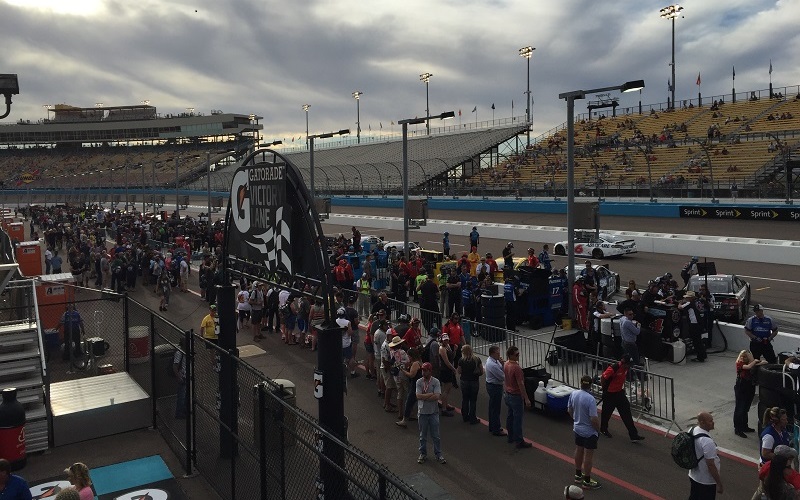
“Phoenix (International Raceway) is a fun track to race since it’s such a different configuration than anywhere else we go. It’s a place where passing is a little more difficult,” Matt Kenseth said. (Photo by Nick Krueger/Cronkite News)
AVONDALE — Phoenix International Raceway, when stripped to the bare minimum, is simply four left turns and a finish line, like most NASCAR tracks. Look a little closer, and the track becomes a jigsaw puzzle which makes the cars more difficult to maneuver on race weekend.
Similarities can be found to other tracks –its ‘D’ shape is seen at other places around the country – but there is nothing quite like PIR with its dog-leg backstretch in which drivers come up and out of turn two before a slight change in direction and a dive down into turn three.
With only one consistent groove, or preferred path on the track for driving, the track lends itself to more single-file racing than two or more cars next to each other. This makes it more difficult to pick up speed by drafting behind a car in order to pass a driver on the lower portion of the track.
“Phoenix is a fun track to race since it’s such a different configuration than anywhere else we go,” said Matt Kenseth, driver of the No. 20 Dollar General Toyota. “It’s a place where passing is a little more difficult.”
In an effort to try and get more two-wide racing, and more drivers passing each other in the process, PIR underwent a $10 million redesign in 2011 that included tightening the turn radius of the dog leg 800 to 500 feet.
Another unique feature of PIR – it does not have an out-of-bounds line. If drivers race below the out-of-bounds line at some other tracks, they might be disqualified. This isn’t the case at PIR, so some drivers will opt to race low in order to cut off the dog leg entirely. PIR is also the only Sprint Cup track west of the Mississippi River that’s less than 1.5 miles around.
One driver who has managed to master the ins and outs of PIR is Kevin Harvick, who will make his 500th consecutive start Sunday in the Good Sam 500. He has won seven Sprint Cup races at the track, including a streak of four straight that was snapped last year.
“Coming to this track, I definitely put the No. 4 (Harvick) as my No. 1 pick,” said Jimmie Johnson, driver of the No. 48 Lowe’s Pro Services Chevrolet.
-NASCAR, Phoenix International Raceway reach out to youngest fans. (Cronkite News video by Zuriel Loving)
The biggest challenge to drivers that came out of the 2011 redesign is the variable banking, in which the steepness of each turn changes as the driver turns the wheel. Turns one and two now bank, or tilt, between 10 and 11 degrees. Turn four banks between 8 and 9 degrees, depending on where the car is racing on the track. The higher the car is on the track, the more degrees of bank.
“It’s tough,” Johnson said. “There’s no way around it. I was probably one of the few that was screaming and yelling, ‘Don’t change this place, don’t repave it, don’t reconfigure it.'”
On most race tracks, the degrees of bank are consistent in all four turns, making it easier for the driver to enter and exit the turns cleanly and with the same amount of speed.
“There are two completely different corners and really it’s like two different race tracks at each end,” said Carl Edwards, driver of the No. 19 Stanley Toyota Camry. “It gives the drivers more opportunity to showcase their skills, communicate what the car is doing.”
The Verizon IndyCar series test run at PIR in early February, done in advance of the IndyCar event the track will host April 2, also gives the track a different feel because of the tire rubber it left behind.
“I think if the rubber is like it is now, if it is Goodyear rubber that we’re seeing, then you’re going to see that in the race,” Edwards said. “You’re going to see the second groove down there and different things down here in turns three and four.”
The variable degree change in the turns makes both pre-race and in-race car adjustments extremely difficult. Add in the typical Phoenix heat, with an 80-degree forecast that lends itself to less tire grip on the track, and it’s a recipe for an exciting Sunday at PIR.
“As the track surface continues to age in Phoenix, the groove moves around, the pace slows up a little bit, and I always feel like the racing just continues to get better,” Kenseth said.